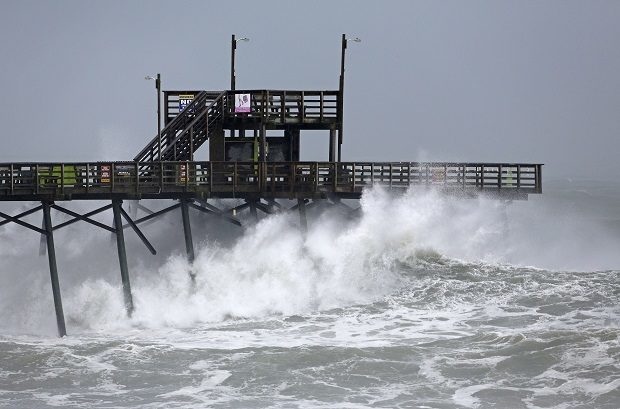Hurricane ‘Florence’ rolls ashore in Carolinas, tears buildings apart

Waves from Hurricane Florence pound the Bogue Inlet Pier in Emerald Isle North Carolina, Thursday, Sept. 13, 2018. (Photo by TOM COPELAND / AP)
WILMINGTON, North Carolina — Hurricane “Florence” lumbered ashore in North Carolina with howling 90 mph (145 kph) winds and terrifying storm surge early Friday, ripping apart buildings and knocking out power to a half-million homes and businesses as it settled in for what could be a long and extraordinarily destructive drenching.
More than 60 people had to be pulled from a collapsing motel at the height of the storm. Hundreds more had to be rescued elsewhere from rising waters, and others could only hold out hope someone would come for them.
“WE ARE COMING TO GET YOU,” the city of New Bern tweeted around 2 a.m. “You may need to move up to the second story, or to your attic, but WE ARE COMING TO GET YOU.”
More ominously, forecasters said the onslaught on the coast would last for hours and hours because Florence had come almost to a dead halt at just 3 mph (6 kph) as of midday.
There were no immediate reports of any deaths.
Article continues after this advertisementFlorence made landfall as a Category 1 hurricane at 7:15 a.m. at Wrightsville Beach, a few miles east of Wilmington, not far from the South Carolina line, coming ashore along a mostly boarded-up, emptied-out stretch of coastline.
Article continues after this advertisementIts storm surge and the prospect of 1 to 3½ feet of rain were considered a bigger threat than its winds, which dropped off from an alarming 140 mph – Category 4 – earlier in the week.
Forecasters said catastrophic freshwater flooding is expected well inland over the next few days as Florence crawls westward across the Carolinas all weekend.
The area is expected to get about as much rain in three days as Hurricanes Dennis and Floyd dropped in two weeks in 1999.
Preparing for the worst, about 9,700 National Guard troops and civilians were deployed with high-water vehicles, helicopters and boats that could be used to pluck people from the floodwaters.
Florence was seen as a major test for the Federal Emergency Management Agency, which was heavily criticized as slow and unprepared last year for Hurricane Maria in Puerto Rico, where the storm was blamed for nearly 3,000 deaths in the desperate aftermath.
The National Hurricane Center said Florence will eventually make a right hook to the northeast over the southern Appalachians, moving into the mid-Atlantic states and New England as a tropical depression by the middle of next week.
For people living inland in the Carolinas, the moment of maximum peril from flash flooding could arrive days later, because it takes time for rainwater to drain into rivers and for those streams to crest.
Authorities warned, too, of the threat of mudslides and the risk of environmental havoc from floodwaters washing over industrial waste sites and hog farms.
On Friday, coastal streets in the Carolinas flowed with frothy ocean water, pieces of torn-apart buildings flew through the air, and at least 525,000 homes and businesses were without power, nearly all of them in North Carolina.
The few cars out on a main street in Wilmington had to swerve to avoid fallen trees, metal debris and power lines. Traffic lights out of order because of power failures swayed in the gusty wind.
Roof shingles were peeled off a hotel.
At 11 a.m., the center of Florence was about 20 miles (30 kilometers) southwest of Wilmington, its winds down to 80 mph (130 kmh), according to the hurricane center. Hurricane-force winds extended 80 miles (130 kilometers) from its center, and tropical-storm-force winds reached out 195 miles (315 kilometers).
The Wilmington airport had a wind gust clocked at 105 mph (169 kph), the highest since Hurricane Helene in 1958, the weather service said.
Sheets of rain splattered against windows of a hotel before daybreak in Wilmington, where Sandie Orsa of Wilmington sat in a lobby lit by emergency lights after the electricity went out.
“Very eerie, the wind howling, the rain blowing sideways, debris flying,” said Orsa, who lives nearby and feared splintering trees would pummel her house.
Forecasters said Florence’s surge could cover all but a sliver of the Carolina coast under as much as 11 feet (3.4 meters) of sea water.
The rising sea crept toward the two-story home of Tom Copeland, who lives on a spit of land surrounded by water in Swansboro.
The water “is as high as it’s ever been, and waves are breaking on my point, which is normally grass,” said Copeland, a freelance photographer for The Associated Press. “Trees are blowing down in the wind. Nothing’s hit the house yet, but it’s still blowing.”
In Jacksonville, next to Camp Lejeune, firefighters and police fought wind and rain as they went door-to-door to pull people out of the Triangle Motor Inn after the cinderblock structure began to crumble and the roof started to collapse.
Farther up the coast, in New Bern, about 150 people waited to be rescued from flooding on the Neuse River, WXII-TV reported. New Bern Mayor Dana Outlaw told The Charlotte Observer about 200 people already had been rescued by 5 a.m.
The worst of the storm’s fury had yet to reach coastal South Carolina, where emergency managers said it was not too late for people to get out.
“There is still time, but not a lot of time,” said Derrec Becker of the South Carolina Department of Emergency Management.
More than 12,000 people were in shelters in North Carolina and 400 in Virginia, where the forecast was less dire. Officials said some 1.7 million people in the Carolinas and Virginia were warned to evacuate, but it was unclear how many did.
More than 3,000 inmates at North Carolina prisons and juvenile detention centers were moved out of the storm’s path.